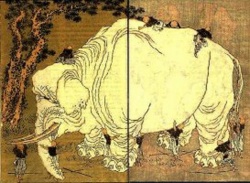Difference between revisions of "Parable"
Jump to navigation
Jump to search
| Line 1: | Line 1: | ||
[[File:Parabels.jpg|thumb|250px|]] | [[File:Parabels.jpg|thumb|250px|]] | ||
| − | A [[parable]] ([[upamākathā]]) is a brief story told to make a [[moral]] point and a [[simile]] ([[upamā]]) is a figure of [[speech]] that compares one thing with another for {{Wiki|didactic}} purposes. Being a [[teacher]] of remarkable creativity and skill, the [[Buddha]] was a [[master]] of the use of parables and similes. When asked a question, the [[Buddha]] would often say before replying: ‘I shall give you a simile, because some smart [[people]] understand better by means of a simile.’ (S.II,114). The [[Jātaka]] is a collection of parables told by the [[Buddha]]. Throughout the [[Sutta Piṭaka]] there are roughly 550 similes, many of them ingenious, apt and memorable. See [[Blind Men And The Elephant]]. | + | A [[parable]] ([[upamākathā]]) is a brief story told to make a [[moral]] point and a [[simile]] ([[upamā]]) is a figure of [[speech]] that compares one thing with another for {{Wiki|didactic}} purposes. Being a [[teacher]] of remarkable creativity and skill, the [[Buddha]] was a [[master]] of the use of [[parables]] and similes. When asked a question, the [[Buddha]] would often say before replying: ‘I shall give you a [[simile]], because some smart [[people]] understand better by means of a [[simile]].’ (S.II,114). The [[Jātaka]] is a collection of [[parables]] told by the [[Buddha]]. Throughout the [[Sutta Piṭaka]] there are roughly 550 [[similes]], many of them ingenious, apt and memorable. See [[Blind Men And The Elephant]]. |
Similes of the [[Buddha]]: An Introduction, Hellmuth Hecker, 2009. | Similes of the [[Buddha]]: An Introduction, Hellmuth Hecker, 2009. | ||
Latest revision as of 13:41, 23 December 2013
A parable (upamākathā) is a brief story told to make a moral point and a simile (upamā) is a figure of speech that compares one thing with another for didactic purposes. Being a teacher of remarkable creativity and skill, the Buddha was a master of the use of parables and similes. When asked a question, the Buddha would often say before replying: ‘I shall give you a simile, because some smart people understand better by means of a simile.’ (S.II,114). The Jātaka is a collection of parables told by the Buddha. Throughout the Sutta Piṭaka there are roughly 550 similes, many of them ingenious, apt and memorable. See Blind Men And The Elephant.
Similes of the Buddha: An Introduction, Hellmuth Hecker, 2009.
